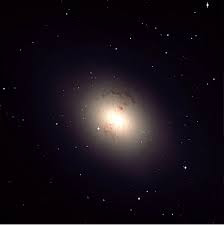 |
| Nebula and Stars |
Types of Galaxies
1) Normal Galaxy : Galaxies are huge collection of stars, dust and gas. They usually contain several million to over a trillion stars.They are formed by gravitational attraction of initial mater formed in Universe. The types of normal galaxies were described by Edwin Hubble. The sub-types of Normal Galaxy are :
- Elliptical Galaxy: Elliptical Galaxy is a type of normal galaxy emitting uniform light everywhere.
 |
| Elliptical Galaxy |
- Spiral Galaxy: Our galaxy Milkyway is a spiral galaxy. In spiral galaxy, the center emit more light and the older stars are present at the center and the newer stars are present at the arms of the galaxy.
 |
| spiral galaxy |
- Irregular Galaxy: This type of galaxy is irregular in shape.
 |
| Irregular Galaxy |
2) Peculiar Galaxy: A peculiar galaxy is a galaxy of unusual size ,shape, or composition. Five to ten percent of known galaxies are categorized as peculiar. The sub-types of peculiar galaxy are:
- Interacting Galaxy: When one galaxy is affected by another galaxy they are called interacting galaxy. The two galaxy may affect each other by their gravitational attraction and they may merge or not merge.

Interacting Galaxy
Stars
A star is a localized nebula which under its own gravity contracts so as to attain temperature high enough for thermonuclear reaction due to which light is emitted from the body which makes it visible to us as a star.
Initial temperature of a nebula might be very less upto -173 Celsius. A nebula primarily being composed of hydrogen contracts due to its own gravitation. Which contracting, it reaches to a stage called Protostar. A protostar is a precursor to a star where the temperature might reach upto 10^7 degree Celsius. Once the temperature reaches to a point where the thermonuclear reaction can start, then the protostar starts consuming its hydrogen content and create helium due process of fusion i.e thermonuclear reaction and finally emit energy in form of visible radiation.
So at first stage it remain nebula , then second stage it forms protostar and third stage a main sequence star. This process continues till the hydrogen is there.
The conversion of hydrogen to helium first starts at the core, once the hydrogen is fully consumed at the core, the temperature at core of star decreases and the core begin to contract. Hydrogen is consumed at core but at the outer part, the hydrogen is still there and fusion still goes on at the outer part and it expands. Finally the core contracts and outer part expands due to which the star becomes unstable and when it becomes unstable, it explodes.
Once the main sequence star explodes, it become a Red Giant i.e fourth stage. It is called the red giant as energy is decreasing. In red giant stage, the star will engulf everything around it to a very large extent.
After the Red Giant stage, the other stages of a star depends upon Chandrasekhar Limit. According to which:
1) If the size of main star is smaller than 1.44 time the sun(Chandrasekhar limit), then after the Red Giant the star will turn into a Planetary Nebula. A planetary nebula is a nebula which can lead to formation of planets. After the Planetary nebula, it will turn into a White dwarf. In white dwarf stage, the helium will be converted into next higher or heavier element by the process of thermonuclear reaction. When all the helium will be converted then white dwarf will turn into a Black Dwarf. Black dwarf continues to contract and further convert the new element to next higher element. Now again this black dwarf will turn into a white dwarf and again white dwarf will be converted to a black dwarf and this cycle will continue.
2) If the size of main star is greater than 1.44 time the sun(Chandrasekhar limit), then the red giant will be turned into a Super Nova Explosion. A super nova explosion releases as much amount of energy that a sun may release in 100 years. After super nova explosion, the next stages depend upon:
- If the size of main star is less than 3 times of our sun, then after the super nova explosion it will become a Neutron Star. A neutron star will then turn into a Pulsar. A pulsar is a pulsating star and it spins a very high speed and very precisely like an atomic clock. A pulsar will further turn into a Magnetar. A magnetar is a pulsar with magnetic field which rotate slower than a pulsar.
- If the size of main star is greater than 3 times of our sun, then the super nova explosion will turn into a Black Hole. A black hole is a region with infinite density and very high gravitation such that it does not allow even light to escape through its gravitational pull.
Binary star: Binary star is a pair of star. Two star which spin around each other because of the gravitational attraction of each other and after a long period they finally collide. This collision will create a gravitational wave which will travel in space.
 |
| Binary star |






0 Comments